From Air Conditioned Underwear to Covered Walkways
Sidewalks and Singaporean Public Space
~ 1,600 words, an eight-minute read
At the turn of the millennium, the Wall Street Journal published an article in which they asked world leaders to identify the most influential invention of the past thousand years. The responses, which came from a menagerie of diplomats, presidents, Nobel winners, and business titans were, as you might guess, quite diverse. But from the perspective of urban planning, one response outshines the rest. That would be the one by Singapore’s late prime minister, Lee Kuan Yew, quoted here in its entirety:
The humble air conditioner has changed the lives of people in the tropical regions. Before air-con, mental concentration and with it the quality of work deteriorated as the day got hotter and more humid. After lunch, business in many tropical countries stopped until the cooler hours of the late afternoon.
Historically, advanced civilizations have flourished in the cooler climates. Now lifestyles have become comparable to those in temperate zones, and civilization in the tropical zones need no longer lag behind.
The ideal invention would be a light polyester air-conditioned undergarment, enclosed around the neck, wrists and ankles and battery operated. Everyone can then work at his optimum temperature and civilization can spread across all climates. [1]
Without such an advanced wearable commercially available, the Prime Minister apparently resorted instead to an intense interest in urban design as a strategy to provide thermal comfort. Here he would have some success, at least in the public realm which his government could easily develop.
First, it’s worth understanding the perspective Lee had on the matter. As documented in a well-known essay by Cherian George, Lee had something of an obsession with seemingly minute details in the physical environment. While following him around a tree-planting event at a newly completed park, the rookie Straits Times reporter observed his unhappiness with the lack of shade:
The pavement was so broad, [Lee] said, that the trees, even when fully grown, would leave large areas exposed to the sun. He noted that although the sun had nearly set, one could feel the heat through the soles of one’s shoes. He squatted suddenly and placed a palm inches off the ground. He could sense the heat radiating from the pavement, he said. [2]
As an internationally renowned figure virtually synonymous with the advent of independent Singapore itself, Lee’s attention to these matters may strike some as somewhat petty and municipal. However, it is perhaps less surprising in the context of the island’s consistently oppressive weather immediately apparent to anyone who leaves the airport. And Lee was not the first head-of-state in Singapore to be concerned with pedestrian comfort.
That honor probably goes to Sir Stamford Raffles, the “other” founding father of Singapore. [3] In his case, British-colonial-entrepot Singapore. As an instruction along with the publication of the first urban plan of the city, Raffles decreed that “each house should have a verandah of certain depth, open at all times as a continued and covered passage on each side of the street.” [4] This would lead to the iconically consistent streetscape condition still evident today where traditional shophouses remain. As it has come to be known in other cities with colonial architecture in Southeast Asia, the resulting shophouse-with-verandah condition is known as the “five-foot way”. The usage of imperial measurement is a key indicator of its British origin.
A healthy amount of ink has been laid analyzing various architectural, social, and historical aspects of the five-foot ways in Singapore and elsewhere, including but not limited to the following: [5]
Conflicts resulting from various interpretations of what is in fact “public” versus “private” in the “Verandah Riots” of the late 1800’s, as analyzed by Belinda Yuen in Contesting Space: Power Relations and the Urban Built Environment in Colonial Singapore
Legal considerations with regards to the “5FW” in light of its role as a unique facilitator of interaction between public and private domains in “Five-foot Ways as an Embodiment of Public and Private Rights: The Origin, Survival and Preservation of Spatial Heritage in Singapore and Beyond” by Andrew Harding
A sometimes amusing read on Rice Media by Pan Jie that speculates about architectural origins of the colonial-era five-foot ways in “Under One Roof: How The Covered Walkway Conquered Singapore” (link)
In any case, the five-foot ways that remain in Singapore today are largely conflict free and generally enjoyed by locals and tourists, pedestrians of all ages and shop owners alike. Architecturally speaking, there is a lot variation in their colors, materials, height, decorations, lighting, adjacent businesses, and even width: many five-foot ways are actually four-foot ways, or six-foot ways, or ten-foot ways. Admittedly, those with accessibility needs probably do not appreciate one aspect of them: the seemingly random steps or sudden changes in floor level or incline. But in general, the visual charm of the ways is as irresistible to anyone with a camera as the breezy shade is comforting to the drifting body. Or the umbrella-less individual who finds that Singapore’s network of covered spaces allows for unexpectedly lengthy outdoor journeys through the city, even in violent downpours. Why carry such a device when urban design will protect you? The question is deeper than it might seem.
All photos in this article taken in spring 2022 and by author.
But before discussing umbrellas, another kind of urban design feature needs attention. Insofar as the five-foot way saw a great deal of variety within a consistent spatial framework, so too did the covered walkways implemented by Lee Kuan Yew’s newly-independent Singapore produce variations on a theme. And the strategy for this second genre of sidewalk enclosure can best be summed up as an ambitious endeavor to cover as many walkways as practically possible with metal canopies. [6] Like their colonial predecessors, these structures were also the result of a plan: the 1989 “Ten Year Walkway Masterplan”. [7] Today, they are officially known by the Urban Renewal Authority (URA) as “Covered Walkway and Linkages”. [8]
More obvious than any conceptual similarities, though, are the blatant architectural differences between colonial and modern covered walkways. Built almost exclusively with steel rather than a plaster-covered timber or masonry frame, modern covered walkways are also often completely liberated from buildings. They snake around the island this way and that, and bear witness to subtle feats of structural gymnastics, like when a sidewalk ends at an intersection. There, rather than leaving pedestrians without cover while on the crosswalk, the canopies lift themselves several meters to allow vehicular passage while still providing some protection to passers under.
Always measured in meters rather than feet, these steel-shed like armatures were deployed alongside the (also) swift construction of the MRT. [9] Perhaps most commonly known today as connectors between transit stations and housing blocks, covered walkways are a fixture of middle-class commuting life in Singapore. And they have proliferated extensively since the late 1980’s, with an extraordinary milestone achieved in 2018: 200 linear kilometers of covered walkways completed. [10]
If one were in search of a paragon of the Singaporean government’s communally minded technocratic prowess, look no further than the Covered Walkway. Or more precisely, behold the incomprehensible complexity of 200km (and counting) of Covered Walkways and Linkages. It is unquestionably a utilitarian symbol of the People’s Action Party’s ability to provide a comfortable, high-quality built environment through skillful coordination and implementation across sectors. Such a conclusion must have been on the minds of the users who made the hilarious Facebook group: “Singaporeans supporting the government because of covered walkways”. Is there truth within satire?
Covered walkways are showing no signs of slowing their spaghetti-monster-like spread around the island. It may very well be possible to predict the day in which an uncovered sidewalk is treated as a novel condition. This is perhaps unsurprising in a nation where the government directly owns 90% of the land and enjoys immense control over the remainder. But naturally, the question is raised: where don’t covered walkways cover walkways? Here’s a crude heuristic, drawing on a similar observation made in the Rice Media piece linked earlier: insert a qualifier other than “middle” here: _____-class neighborhood. [11] Such areas are often beyond a planners gaze. (Such a statement is probably worth an investigation best dealt with in a completely separate article.)
But actually, it might be even simpler than that. At, say, 200km x 3m, the area contained by covered walkways is (roughly) just 0.6 sq. km. That’s a microscopic slice of land even in a country that’s just 42km wide. Which raises another question. What exactly are the covered walkways designed to connect?
Well, one answer is implicit in Lee Kuan Yew’s statement and in the fact that these developed in tandem with public transit. Covered walkways are oil in the machine of the daily grind. Beneath promises of bodily comfort lie quantitative gains in economic productivity.
That’s all well and fine, since, well, covered walkways don’t just grow on trees you know! But it’s worth closing with a little perspective. Taking the day off from a regular weekday commute? Take an umbrella, since recreational destinations may not have covered passage. Curious about exotic streetscapes yet left uncovered by sheet metal? Umbrella.
The air-con’ed clothing dreamed of by the late Prime Minister remains basically unrealized to this day. When such a skinsuit is purchasable, our bodies may finally be liberated from the ravages of weather. But for now, an umbrella is a practical alternative that unlocks at least some individual agency. And it’s not just a rain-deflector.
Umbrellas block the tyrannical tropical sun, too.
© 2022 James Carrico
Footnotes:
Lee Kuan Yew, 1999, response in “The Millennium's Most Influential Innovations”. The Wall Street Journal. January 11, 1999. https://www.wsj.com/articles/SB915764828134990000?mod=Searchresults_pos16&page=1 (accessed May 12, 2022).
George, Cherian. 2020. Air-Conditioned Nation Revisited: Essays on Singapore Politics. Ethos Books, 18.
Though it’s possible a pre-colonial ruler or some sort was also worried about these things. I’m simply not sure based on where I am with my reading, now.
Charles Burton Buckley. 1902. An anecdotal history of old times in Singapore. Fraser & Neave, limited, 84. The first plan of British colonial Singapore is known as the 1822 Jackson Plan.
In the words of one advisor: “They’ve been studied to death.”
This point is almost too important to be a footnote: there are are certainly more than two genres of covered sidewalks in Singapore. More on that in another article.
Referenced in Hee, Limin. n.d. Constructing Singapore Public Space. Singapore: Springer Singapore. https://doi.org/10.1007/978-981-10-2387-3. I actually can’t find this document itself, so if anyone knows where it can be located please let me know!
See the URA website, i.e. https://www.ura.gov.sg/Corporate/Guidelines/Development-Control/gross-floor-area/GFA/CoveredWalkwayandLinkages
Mass Rapid Transit: the Singapore subway system
See Land Transport Authority press release here: https://www.lta.gov.sg/content/ltagov/en/newsroom/2018/9/2/factsheet-lta-completes-200km-of-sheltered-walkways-under-walk2ride-programme.html
This is another key difference from colonial five-foot ways. By contrast, those can be indicative of a wide range of classes, from luxury hotels with ornate details in renovated buildings to ordinary coffee shops to aging building stock that provides naturally occurring affordable retail space.
© 2022 James Carrico






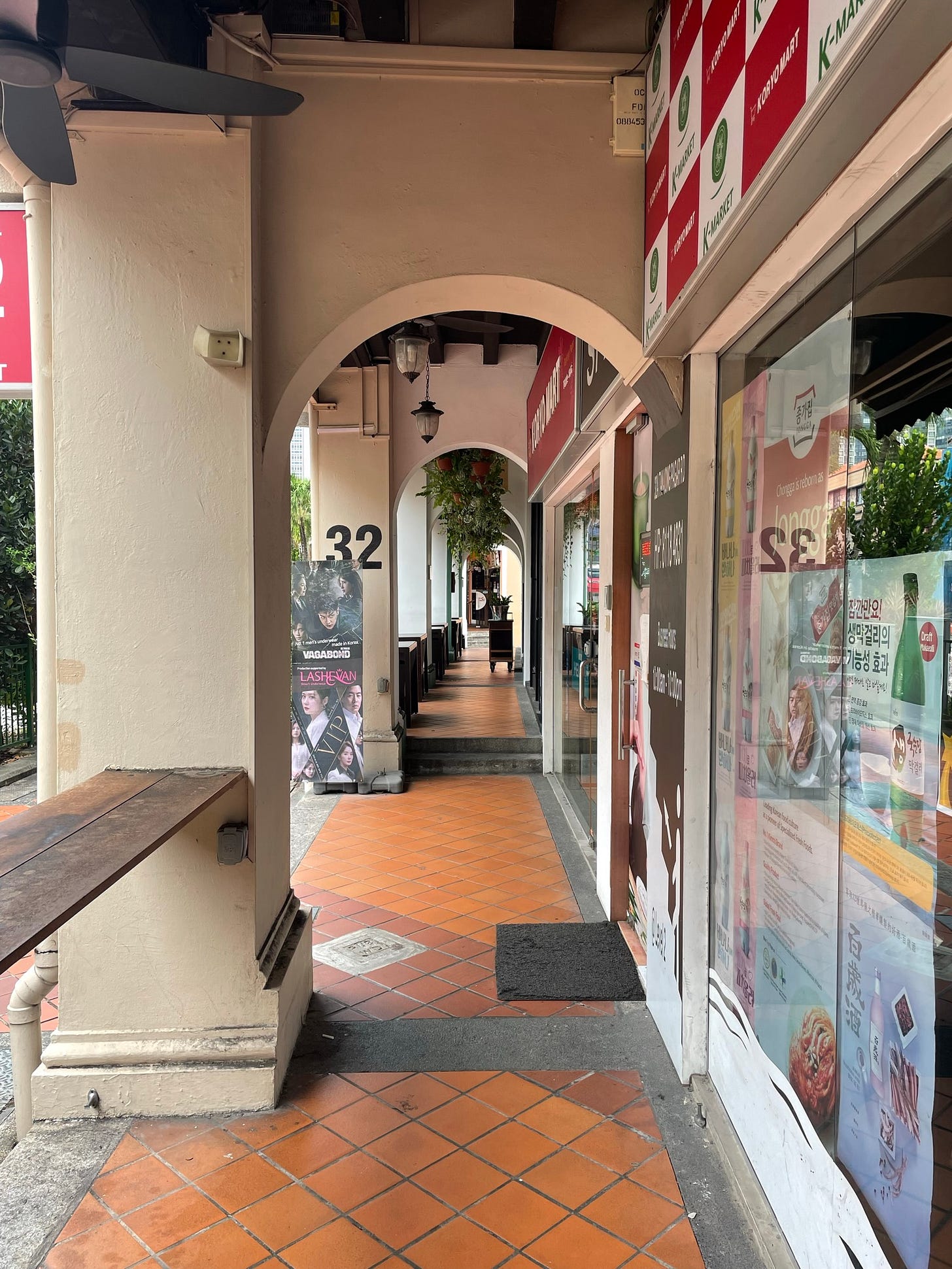
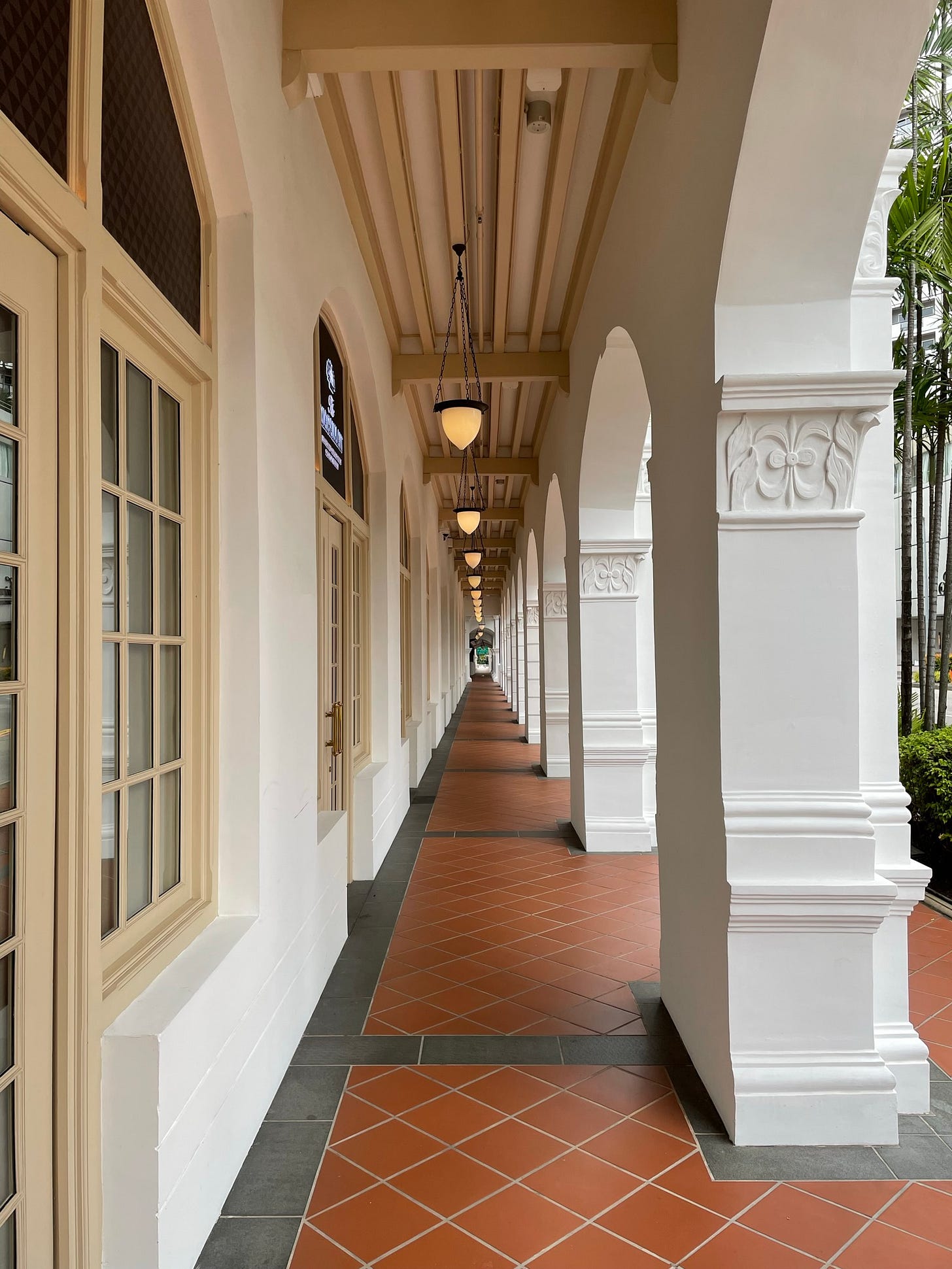
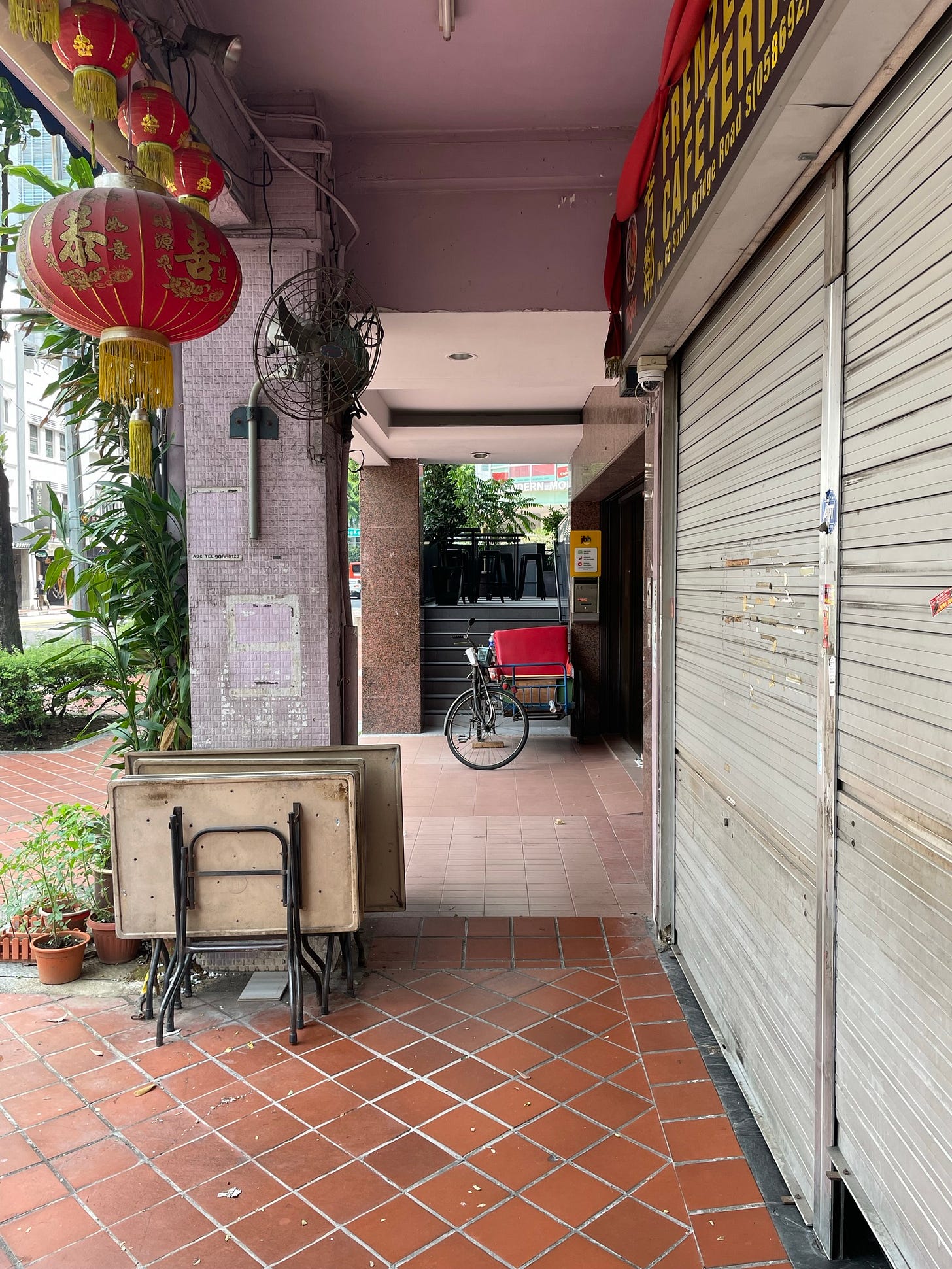
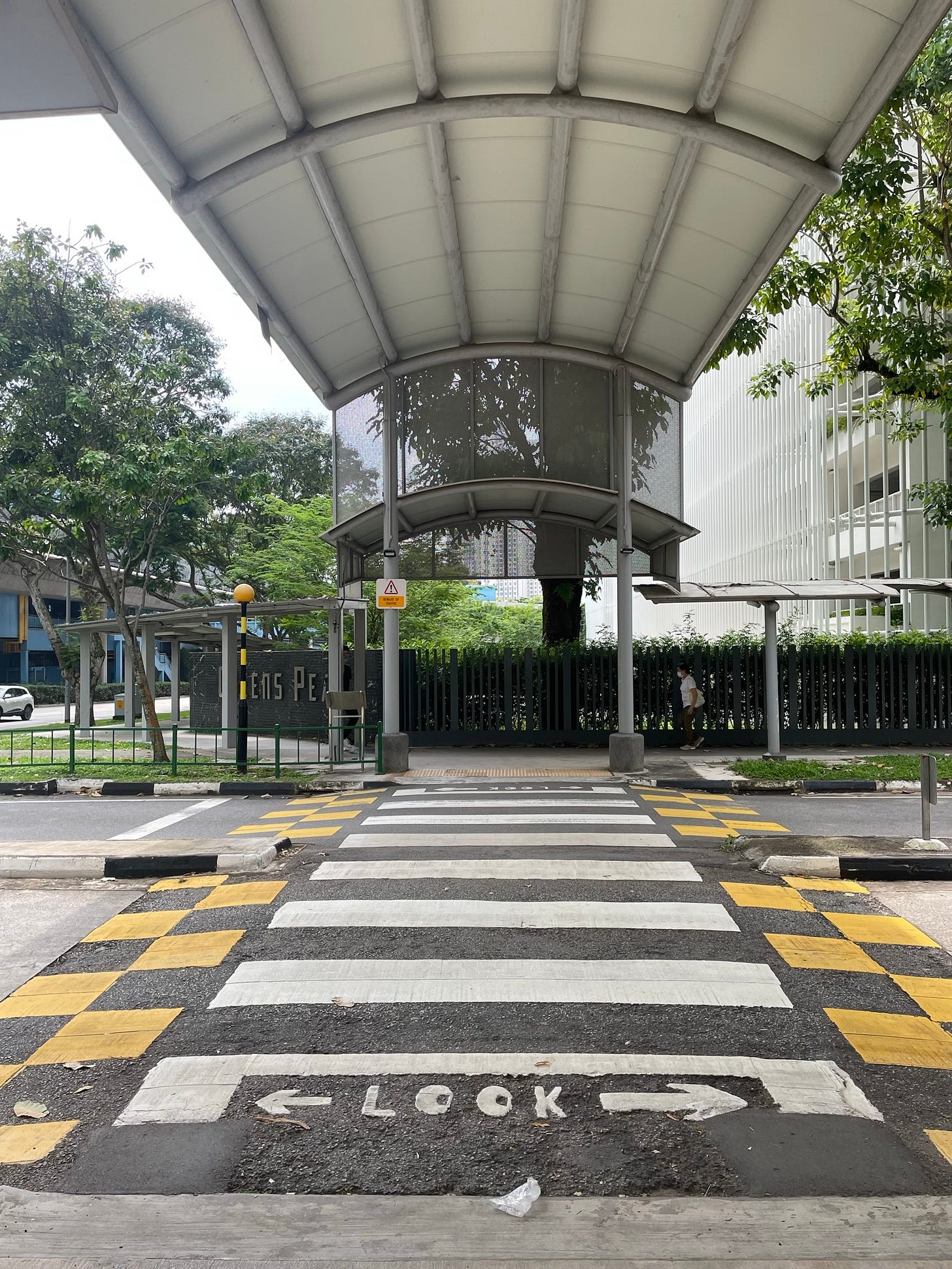

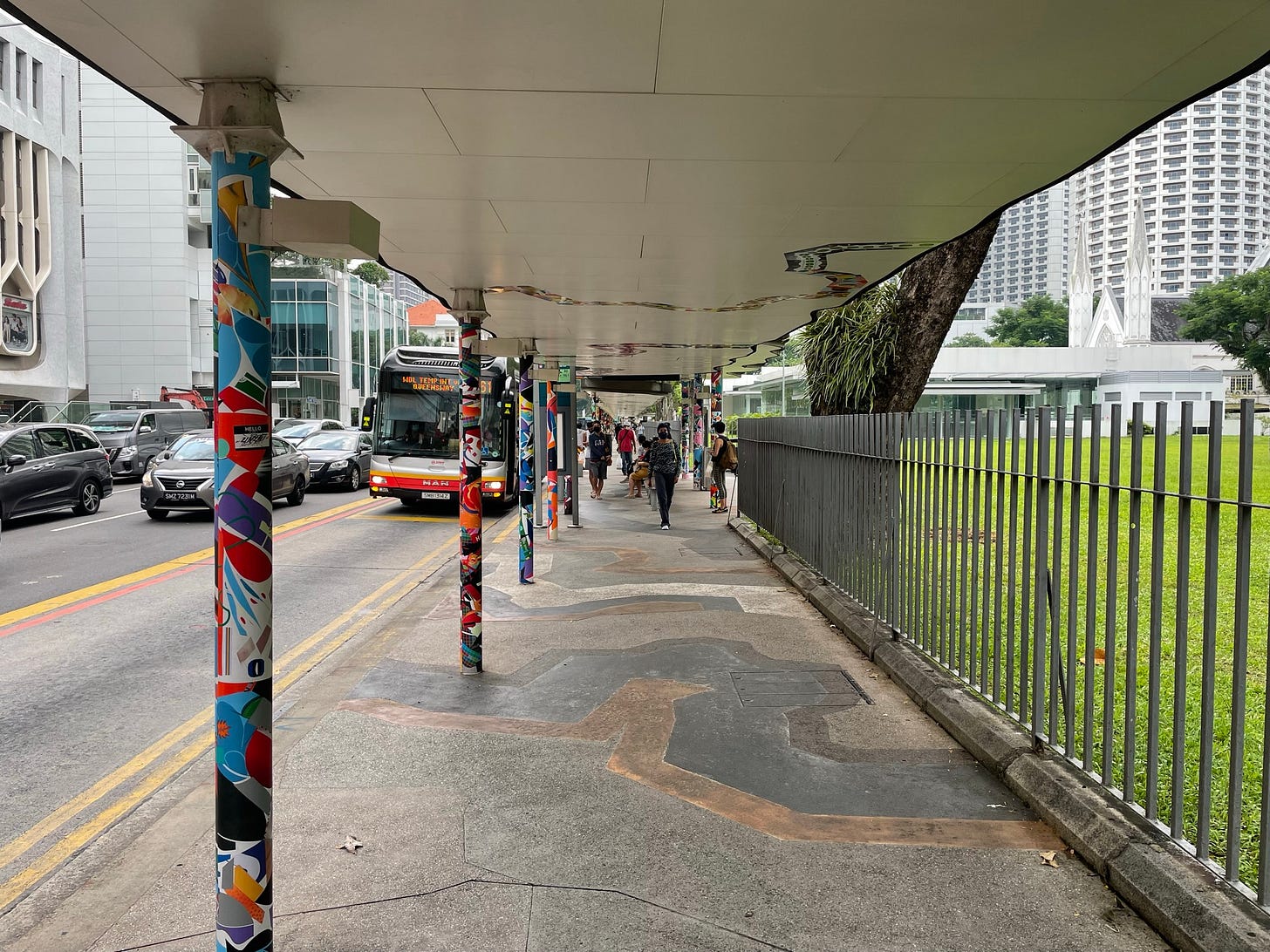

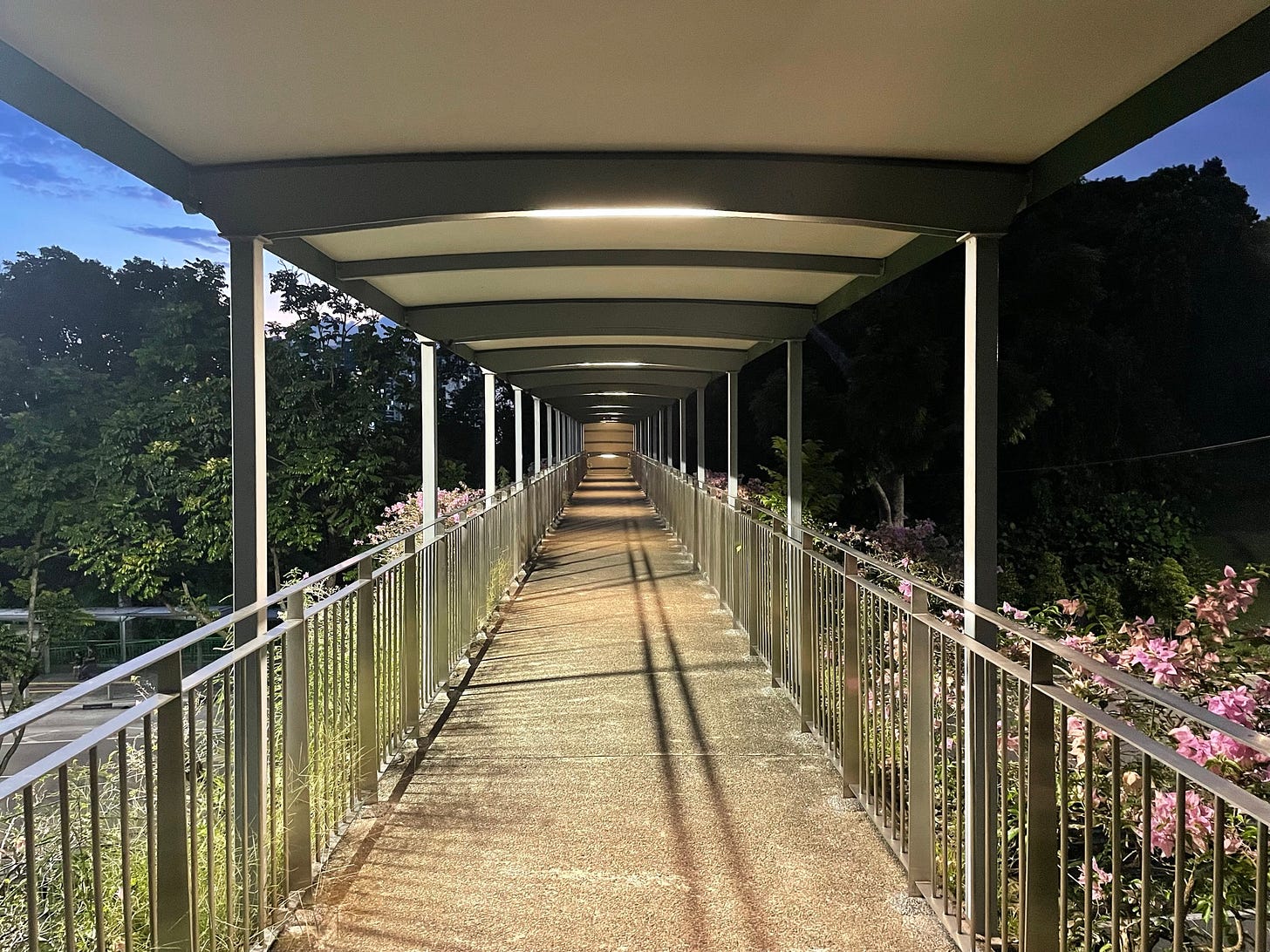
Cover these walkways with photovoltaic panels!
Inspiring. Thank you!